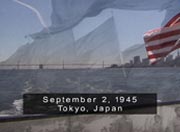
Movements East—West 2003 / 17 Minutes NTSC / Stereo / Color / B&W / Digital video Distributed by: mingyuen@earthlink.net |
 |

Movements East—West, the third in Ma’s Xin Lu project, explores histories of movement—both in the physical movement of travel, and in revolutionary movements for political and social change. This experimental video is structured as a composite timeline of sixty dates and places, starting in 1841 and ending in 2001. In this chronology, significant dates in Ma's personal and family history mingle and intersect with world historical events, showing the larger social and political forces behind his migrations. Ma's life experiences are contextualized by events including the Prodemocracy demonstrations in China; AIDS activism in the U.S.; the Asian American, Gay Liberation, and Civil Rights Movements of the 1960s and '70s.
Archival images of these marches and demonstrations are combined with footage Ma shot during his travels in China, Europe, and the U.S. In these sequences, images of airports, train stations, harbors, and stretches of freeway show the familiar yet transitory spaces encountered on a journey. Touristic images in his family's Super-8 home movies add yet another layer of displacement to the video. Quotations from texts by Jack Kerouac, Esma'il Kho'l, Rey Chow, Giles Deleuze and Félix Guattari are scanned with a digital camera and combined with images of the luggage that Ma has carried with him since he left home twenty years ago. These are tagged with the dates in which they are used and photographed in extreme close-up to show the markings of many journeys.
These layers of images are synthesized through digital compositing, and a soundtrack composed from recordings made during Ma's travels accompanies them. Ultra Red, a Los Angeles-based audio collaborative that combines political direct action with ambient site recordings, created this soundtrack specifically for the video. The visual and audio layering in this video show the merging of history and memory in a continuous flow of image and sound, while strategic pauses in this flow reveal a tension between the sense of suspension in a deterritorialized existence and the historicity of socio-political movements depicted. These fluctuations in time and space recreate an uncanny sensation, most often experienced while traveling, when the past, present, and future all seemed visible in the same instant.
For info. on Ultra Red, go to their web site
Read more on Xin Lu Project